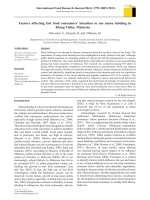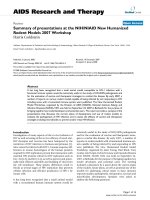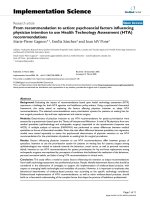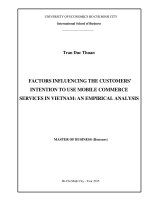Summary of Doctoral thesis: Studying the intention to use Ebanking services of customers at Vietnamese commercial banks
Bạn đang xem bản rút gọn của tài liệu. Xem và tải ngay bản đầy đủ của tài liệu tại đây (367.14 KB, 25 trang )
1
INTRODUCTION
1. Necessity of the research
At present, the majority of the Vietnam banking are
in the early stages of providing E-banking services. In
fact, many people in VietNam has not used all the tools
and banking services. People also tend to use online
services accounted for the higher rate. Development
services from around 2010, up to now 74% commercial
banks (commercial banks) to develop Internet Banking
services, 38% of commercial banks develop mobile
banking services. Research on the factors affecting the
intention to use Ebanking services of customers has been
studied by many domestic and foreign researchers and
research theories. Some researchers use theoretical
backgrounds such as TRA, TPB, TPR, TAM, and IDT.
Many factors influence the intention to use Ebanking
services such as ease of use, perceived usefulness,
perceived risk, innovative technology, ... Venkatesh's
UTAUT model (2003) developed more influential factors
such as social determinants, regulatory variables (gender,
experience, age, etc.) affect the intention to use the
service and the additional effects of the regulation to the
level of influence factors on the intention to use Ebanking
services.
Consumer behavior research on the basis of
consumer behavior theory also helps investors who are
more properly oriented in developing Ebanking services.
1
2
Recognizing the urgency, many Vietnamese researchers
have made some research results which mainly in the
form of articles, scientific paper, research journals,
research on Ebanking services in some different areas,
and most studies have not mentioned the impact of
elements. and most studies have not mentioned the
impact of elements. There is no difference in in the use of
services in the different regions, the perceived factors was
less interested in studies. The cost factor has not been
fully the theory while cost perception is one of the key
factors affecting the development of services.
Stemming from the above reasons, I chose the
topic: "Studying the intention to use Ebanking services of
customers at Vietnamese commercial banks" to do
research.
2. Researching Objectives
The research objectives were concretized by the
following questions:
- Factors affecting the intention to use Ebanking
services of customers? The impact of each factor to the
trend of using Ebanking service?
- How do demographic variables affect the impact
of factors on the intention to use Ebanking?
- Based on the results of the study, the author has
made some recommendations for commercial banks and
State banks, thus helping to increase customers and
develop Ebanking services.
2
3
3. Objects and scope of the research
3.1. Objects of research: The study subjects
consisted of two main subjects: Theoretical
considerations on factors affecting purchase intention and
the factors affecting the customers' intention to use
Ebanking services at commercial banks in Vietnam.
3.2. Scope of Research: Studying individual
customers in some cities: Hanoi, Ho Chi Minh City. The
study period: From 2015 to 2017.
3. Research Methodology
To achieve the research objectives, the topic uses a
combination of qualitative, quantitative, interview and
some models to study and analyze some relevant
contents.
5.Contributions of the thesis
The thesis accomplishes the objectives set out in the
study:
- An overview of the research on the intention to
use Ebanking services and the basic theory of behavioral
intentions that builds up the research model.
- Verification of research models, confirming the
hypotheses about the relationship between the factors
affecting the intention to use Ebanking services.
- From the research results, the thesis proposes
some suggestions for commercial banks to enhance their
intention to use Ebanking services and some macro
3
4
recommendations to promote the development of
Ebanking services in Vietnam.
6. Thesis structure
Besides introduction, conclusion, reference,
appendix, the main contents of this research are
represented in 5 chapters:
Chapter 1. The theoretical basis and research
overview of the intention to use Ebanking service.
Chapter 2. The current status of using Ebanking
services of customers in some commercial banks in
Vietnam
Chapter 3. Research Methods and Research Models
Chapter 4. Research of intention to use Ebanking
service at Vietnamese commercial banks.
Chapter 5. Conclusion and recommendations
CHAPTER 1: THEORETICAL BASIC AND
RESEARCH OVERVIEW
1.1. Ebanking
1.1.1. The concept of Ebanking
There are many different interpretations of the
concept of Ebanking. In English, Ebanking is Electronic
Banking, abbreviated to Ebanking. There are many
different expressions about "Ebanking". The most general
concept of Ebanking can be expressed as follows:
"Ebanking includes all types of transactions between
banks and customers based on the processing and transfer
4
5
of data digitization to provide banking" (Dr. Nguyen
Minh Kieu, 2007).
1.1.2. Intention to use banking services
In this study, the author uses the intention to
purchase as a willingness to use the customer's service
(Elbeck, 2008) to predict purchasing intent as an initial
step to predict the actual behavior of the customer
(Howard and Sheth, 1967) and the basis for predicting
future demand (Warshaw, 1980; Fishbein and Ajzen,
1975). Intention to use Ebanking service is understood as
motivation to take action, decision to accept or not accept
using Ebanking service in the future.
Research on the relationship between intention to
use the service and accept the use of services has a lot of
domestic and foreign researchers has launched many
theories prove and assert the factors that impact the
consumer behavior of the customers. However, in this
issue, the article only gives some important theories to
study the intention to accept and use the service of
consumers.
1.2. The basic theory of intention to use
Ebanking service
1.2.1. Theory of Reasoned Action (TRA)
The Rational Action Theory was developed by
Ajzen and Fishbein in 1967 and revised over time. The
TRA model (Ajzen and Fishbein, 1975) shows that
consumer trends are the best predictors of consumer
5
6
behavior. To better understand the factors that contribute
to consumer trends, two factors are considered: consumer
attitudes and standards.
1.2.2. Theory of planned Behaviour (TPB)
Reasonable action theory TRA is limited to predicting
the performance of consumer behaviors that they can not
control; Behavioral factors and subjective norms are not
sufficient to explain the behavior of consumers. Thus, the
theory of planned behavior (TPB) was developed by Ajzen
(1991) by adding a cognitive behavioral control component
to the TRA model. Behavioral cognitive component reflects
the ease or difficulty of performing behavior; This depends
on the availability of resources and opportunities to perform
the behavior.
Behavioral awareness is related to the perception of
how easy or difficult it is to behave, it is also assumed to
reflect past experience as well as anticipated obstacles.
1.2.3. Theory of Risk perception
According to Beuer (1960) cognitive risk is defined
as consisting of two main components: the probability of
a loss and the subjective feeling of the adverse
consequences. The TPR risk perception theory is that the
consumer behavior of a risky information technology
product is twofold: (1) PRP - Perceived Risk with
Product / Service, (2) Perceived risk in relation to online
transactions. Behavioral cognitive component reflects the
ease or difficulty of performing behavior; This depends
6
7
on the availability of resources and opportunities to
perform the behavior.
Behavioral awareness is related to the perception of
how easy or difficult it is to behave, it is also assumed to
reflect past experience as well as anticipated obstacles.
1.2.4.The Technology acceptance model (TAM)
Based on the two TRA theory, TPB, TAM theory
studies more deeply in explaining the adoption behavior
and use of consumer technology.
Two basic elements of the model are the sense of
usefulness and the sense of ease of use. Sensing
usefulness is "the extent to which a person believes using
a particular system will improve their own performance."
Feeling easy to use is "the extent to which a person
believes using a particular system without effort."
1.2.5.The Innovation Diffusion Theory (IDT)
The theory built by Rogers (1962) is the first to
model IDT that explains innovation and the customer
receives the benefit of that innovation from which to
accept new products.
1.2.6. The theory of acceptance and use of
technology (UTAUT)
The theory of acceptance and use of technology is
investigated by Venkatesh et al. (2003) to explain
behavioral intent and acceptance of users' use of
7
8
technology. UTAUT model is based on the development
of previous models: TRA, TPB, TAM, IDT.
This model was tested by Venkatesh in the United
States to demonstrate optimization in explaining
technology adoption, but behavioral intent and customer
service adoption may also be influenced by Regional,
regional and national geographic features vary.
1.3. Overview of factors affecting the intention to
use Ebanking service
Over the past decade, researchers around the
world have researched many issues related to the Internet
and services online banking (Internet banking) and
banking services through mobile channels (mobile
banking). The overview of the three main factors
influencing the customer's willingness to use the ebanking service is: Customer factors (feel ease of use,
usefulness, innovation, risk ); bank factor (supplier
image, cost) and other factors (social factors,
demographic
variables).
8
9
CHAPTER 2: REALITY OF USING
EBANKING SERVICE BY CUSTOMER IN
COMMERCIAL BANKS IN VIET NAM
2.1. Results of commercial banks in Viet Nam
2.2. Using E-Banking services in Commercial
banks in Viet Nam
2.3. Evaluation about using Ebanking in
Commercial banks in Vietnam
2.3.1. Results achieved
The popularity of the Internet and mobile phones
in recent years has opened up a potential market for
providing Ebanking services in Vietnam. According to
the Ministry of Information and Communications, more
than 50 million Internet users and 130 million mobile
subscribers, with a population of more than 90 million,
now average about two in Vietnam. One person has
Internet access and an average of two mobile subscribers
per user. This is a great potential for developing
Ebanking services.
In addition, the Government and the State Bank of
Vietnam have issued Laws, Circulars, Decrees and
Decisions to create a legal corridor to encourage the
development of Ebanking services.
9
10
Ebanking services are widely offered by banks,
including Internet Banking provided by 45 banks (90%),
Mobile Banking (38%). So far, most commercial banks
have developed Ebanking services.
In parallel with the provision of Ebanking
services, banks increasingly diversify new payment
methods and means of applying high technologies such as
bank cards, electronic money, electronic wallets,
electronic checks.
In addition, commercial banks in Vietnam have
been promoting cooperation with many organizations to
provide products with many utilities for customers. The
rapid development of payment services and electronic
means in recent years has facilitated the payment of
goods and services via the Internet, mobile phones,
ATMs and POS. The link between banks,
telecommunications companies, service providers has
provided more intermediary solutions, support payment
services.
2.3.2.Limitations and causes
a. Limitations
- The bank has not exploited the potential market
for Ebanking services
- Most banks in Vietnam provide simple online
services.
- The quality of Ebanking services is not
satisfactory to customers at higher levels such as
10
11
depositing cash into the account, registering for using the
service ...
- Poor infrastructure such as network quality,
transmission speed, technical errors or terminals fail to
ensure quality leading to poor service quality.
Infrastructure development is not synchronous, new focus
in urban areas, not reach the rural and mountainous areas.
- The banking system of Ebanking is still relatively
independent and has not been coordinated and necessary
to maximize the efficiency of this new service.
- Ebanking transactions are heavily dependent on
traditional storage vouchers, not able to electronic
transaction documents.
- Safety and security of the system.
b. Causes
- Limits of customer psychology.
- The resources of banks are limited (human
resources, technical infrastructure)
- The legal environment is still incomplete and
sync.
- Technology changes with increasing speed,
requiring banks to take new steps faster and more boldly.
However, to do that requires a huge cost. The issue of
information communication introduces, promotes the use,
convenience and use of Ebanking products and services
of banks is not sufficient and timely to the public.
11
12
CHAPTER
METHODS
3.
RESEARCH
MODELS
AND
3.1. Research Model
3.1.1. Overview of concepts and related variables
Based on behavioral theories and results from
previous studies from the review above, the study
proposes some independent variables (factors that
influence the intention to use Ebanking services in the
context (1) Perceived ease of use (DSD), (2) Perceived
useful (HI), (3) Perceived Risk (RR), (4) Social effect
(XH), (5) Innovation (TDM), (6) perceived low cost
(CP), (7) Bank image (HA). Dependent variable is the
intention to use Ebanking service (YDSD).
3.1.2. Research models and research hypotheses
H1: Perceived ease of use will positively influence
bank customer’s intention to use Ebanking service.
H2: Perceived useful will positively influence bank
customer’s intention to use Ebanking service.
H3: Perceived risk has a negative effect on
intention to use Ebanking service.
H4: perceived risk reduces perceived usefulness
H5: Banking image will positively influence bank
customer’s intention to use Ebanking service.
H6: The bank image has the opposite effect on risk
perception.
H7: Perceived low cost will positively influence
bank customer’s intention to use Ebanking service.
12
13
H8: The social impact will positively influence
bank customer’s intention to use Ebanking service.
H9: Social influences have the opposite effect on
risk perception.
H10: Innovation will positively influence bank
customer’s intention to use Ebanking service.
H11: Demographic variables (gender, age, income,
education, region) have different impacts to the influence
of the independent variable on the intention to use
Ebanking service.
Research process through the steps: qualitative
research and quantitative research (including preliminary
quantitative research in narrow scope and formal
quantitative research).
CHƯƠNG 4
THE RESULT OF THE RESEARCH
4.1. Result of preliminary research
The author conducted a survey with 150
questionnaires that collected 110 valid votes between
September 2016 and November 2016 through direct
questionnaire interview.
4.2. Research results official
In the period from December 2016 to March 2017,
700 questionnaires were surveyed to customers in
commercial banks in Hanoi and Ho Chi Minh City. At the
13
14
end of the survey, after the questionnaires were answered
incorrectly, the questionnaire was in short supply. The
research collected all 602 questionnaires completed,
accounting for 86%. The number of questionnaires
eligible for statistical analysis was 602.
4.2.1. The results of evaluating the scale’s reliability
The authors used the SPSS 20 software to analyze
the reliability of each scale before analyzing the resultant
coefficients, indicating that the cronbach's alpha
coefficient and the coefficient of variation were satisfied.
The results of the reliability of CFA scale review shows
all empirical indicators are Cronbach's alpha >0.6,
coefficient and correlation of variables are > 0.3.
4.2.2. Analysis of Exploratory Factor Analysis
(EFA)
After analyzing the reliability of the scale,
removing some inappropriate variables, the author
conducted factor analysis, exploratory research with
assessment criteria:
Results of factor analysis revealed that, KMO coefficient,
Barlett coefficient of sig coefficient; The factor load
factor and the total variance deviation are satisfactory.
Pattern Matrix
Factor
1
2
3
4
5
6
7
14
15
TDM5
TDM2
TDM3
TDM4
TDM1
DSD5
DSD2
HI5
HI1
DSD1
HI4
XH1
XH3
XH7
XH4
HA1
HA3
HA2
HA4
RR1
RR2
RR3
RR5
CP4
CP2
CP1
CP3
.922
.906
.871
.863
.832
.856
.849
.735
.729
.703
.692
.898
.893
.868
.767
.926
.891
.800
.746
-.849
-.836
-.812
-.792
.970
.863
.666
.611
15
16
YD3
YD4
YD1
YD2
.848
.729
.670
.631
The results of the EFA analysis show that the
research model has seven concepts: Innovation (TDM),
including two variables "Perceived ease of use" and "
Perceived useful " into 01 variable ( HI-DSD), "Social
Influence" (XH), "Image" (HA), " Perceived Risk" (RR),
" Perceived low cost" (CP) and "Intention to use
Ebanking service” (YDSD).
4.2.3.
The results of analyzing confirmed factor
CFA
After performing exploratory factor analysis (EFA),
the author performed a CFA assay, the results showed that
the measurement was appropriate: Chi-square / df = 2.307
<3, TLI = 0.954, CFI = 0.957, coefficient RMSEA = 0.047
<0.08, so the model is consistent with the market. The
results of the P-values of the observation variables
representing the factors were sig = 0.000, so that the
observed variables were able to demonstrate good for the
factor in the CFA model. The covariance coefficient and the
reliability of the scales are> 0.5. Thus, it is possible to
confirm that the research scale assures the analysis
requirements.
Results of the correlation coefficient analysis show
that the correlation coefficient between each pair of
16
17
concepts is different from 1, the P-value is <0.05, so it is
possible to conclude the factor components Ease of use,
social impact, risk tolerance, supplier image, low cost
sensitivities, Intent to use are values that distinguish the
relationship. between the components of the scale.
17
18
The result of relationship between the components of
the scale
Estimate
S.E.
C.R.
P
TDM
<--> HI_DSD
.261
.034
7.735 ***
TDM
<--> XH
.177
.028
6.311 ***
TDM
<--> YD
.204
.027
7.554 ***
TDM
<--> HA
.139
.029
4.768 ***
TDM
<--> RR
-.148
.025
-5.880 ***
TDM
<--> CP
.092
.023
4.083 ***
HI_DSD <--> XH
.155
.028
5.454 ***
HI_DSD <--> YD
.200
.027
7.286 ***
HI_DSD <--> HA
.164
.030
5.444 ***
HI_DSD <--> RR
-.159
.026
-6.137 ***
HI_DSD <--> CP
.111
.023
4.777 ***
XH
<--> YD
.194
.024
8.006 ***
XH
<--> HA
.200
.027
7.400 ***
XH
<--> RR
-.278
XH
<--> CP
.258
.023
11.057 ***
YD
<--> HA
.265
.028
9.457 ***
YD
<--> RR
-.190
.023
-8.438 ***
YD
<--> CP
.156
.020
7.794 ***
HA
<--> RR
-.238
.026
-9.186 ***
HA
<--> CP
.212
.023
9.026 ***
.026 -10.805 ***
18
19
Estimate
RR
<--> CP
-.195
S.E.
.020
C.R.
P
-9.538 ***
4.2.4. The results of analyzing confirmed factor CFA
The results of analyzing SEM show that Chi-square
/ df = 3,332 <5, TLI = 0.917, CFI = 0.925, are greater
than 0.9, RMSEA = 0.062 <0.08, so the model is
appropriate for the market. The P-value of the
independent variables is 0.000, so the independent
variables show the influence on the dependent variable is
the intention to use the Ebanking service.
4.2.5. Inspection results of Bootstrap
The author uses the Bootstrap method with repeated
observations of N = 1000. The results showed that absolute
CR <2 could conclude that the deviation was very small and
was not statistically significant at the 95% confidence level.
Thus, we can conclude that the estimation model is reliable.
4.2.6. Result of analysing multi-group structure
The analysis of sex, education, income, age, and
region results in a difference in chi-square between
variable and invariant models and income variables. The
difference between the invariant model and the variability
of the income variable is 8,864, the difference is df 3; the
P-value is calculated on the Excel sheet at 3% = 0.03
<0.05). The difference between the invariant and the
variation of the domain variable is 10.7, the difference is
df 2, the P-value is calculated on the Excel sheet at 0.5%
= 0.005 <0.05). Affirmation of differences in the
19
20
relationship between the factors affecting the intention to
use Ebanking services between groups of customers with
different income, different regions.
The results of the regression analysis show that for
customers with income below 5 million (Pvalue = 0.026),
there is the effect of the low cost sensing variable on the
intention to use Ebanking, since over 5 million (Pvalue>
0.05) showed no effect of the low cost sensory sensor on
the intention of using Ebanking. For regional factors:
customers in the South, social factors do not affect the
intention to use Ebanking service (Pvalue = 0.144> 0.05).
4.3. Discussion of the result
Results of the scale test showed that: Reflected
scales focused on responses with Cronbach's alpha> 0.6;
Variable correlation coefficients - sums> 0.3 and are
smaller than cronbach's alpha coefficients. The
confidence scale can then be further analyzed. Ebanking
(Pvalue = 0.144> 0.05).
The results of the EFA analysis show that the
research model of Ebanking service is intended to show the
impact of the six built-up indicators: Innovation, Feelibility,
Usefulness, Supplier Image Risk perception, Social
Influence, Low cost sensation, which explains 67.89%
change in intention to use Ebanking. The scales selected for
the variables in the model are guaranteed to be required and
used in subsequent analyzes.
20
21
The hypothesis’s results in study are as
follow
Testing results on the research hypothesis is
accepted, stating the following:
The hypothesis H1, H2: Perceived usefulness and
ease to use factor have the related impact to the intention
to use Ebanking service.
The hypothesis H3: Perceived risk has a negative
effect on intention to use Ebanking service.
The hypothesis H4: Perceived risk has a negatively
affecting to usefulness.
The hypothesis H5: Banking image has a related
impact to the the intention to use Ebanking service.
The hypothesis H6: Banking image has a negatively
affects to Risk perception.
The hypothesis 7: Perceived low cost has a related
impact to the intention to use Ebanking service.
The hypothesis H8: The social impact has a related
impact to the intention to use Ebanking service.
The hypothesis H9: The social impact has a
determinant influences the perception of risk.
The hypothesis H10: The innovation of consumers
has a related impact to the intention to use Ebanking
service.
Hypothesis H11 is confirmed: The moderator
variable has different effects on the level of influence of
factors on the intention to use the service.
21
22
CHAPTER
5:
CONCLUSIONS
AND
RECOMMENDATIONS
5.1. Conclusions
In fact, many users of banking services in Vietnam
have not exploited the utilities of each tool and service.
According to the preliminary statistics of the Ministry of
Information and Communications, the Internet users now
account for 53% of the population, Vietnam is a potential
market for the development of Ebanking services
integrated technology applications. modern information.
However, in fact, the number of Ebanking service users is
still small, not corresponding to the potential
development of this service. Therefore, the study of
factors affecting intention to use Ebanking services helps
policy makers and marketers to predict the usage
behavior of customers.
In this study, the authors used SPSS 20 and AMOS
20 software to perform the scale measurement, factor
analysis, and hypothesis testing. The results show the
impact of the factors: Feel easy to use, Feel usefulness,
Social impact, Feel the risk, Supplier image, Feel the cost
(low price) , Innovation affects the intention to use
Ebanking services of customers.
On the direction of the impact of factors on the
intention to use Ebanking service: Hypothesis H1, H2,
H3, H4, H5, H6, H7 are approved affirmation of ease of
use, feeling of ownership Credit, Social Factors,
22
23
Innovation, Positive Impacts with the intention to use
Ebanking services, as these factors increase, the intention
to use Ebanking services will increase; The risk factor
that is counteracting the customer's willingness to use the
Ebanking service is shown when the factor increases, the
customer's willingness to use the Ebanking service will
decrease.
Interaction between factors: hypotheses H8, H9,
H10 are accepted Confirmation of Risk affects negatively
to usefulness; Supplier Image Influence to Risk; The
social impact factor has the opposite effect on the risk.
The effect of demographic variables on the factors
influencing the intention to use Ebanking services
through multivariate analysis is to show that income
earners living in different regions are influenced by
Factors such as ease of use, usefulness, risk perception,
social impact, cost perception (low cost) to the intention
to use Ebanking services are different.
5.2. Proposing petitions:
5.2.1. Proposals to commercial bank:
a. Increased perception of usefulness and ease of
use
b. Strengthening and promoting social influence
c. Solutions on safety, security
d. Solutions on building brand image
e. Solutions on pricing policy
f. Diversify products, focus on product innovation
23
24
5.2.2. Petitions to State Bank and Government:
- Firstly, to formulate a strategy for developing
services for the banking industry, creating a basis for
banks to formulate strategies on activities of products and
services in general and Ebanking services in particular.
- Second: Technology infrastructure development
- Third, take the initiative in supporting banks and
credit institutions in raising the intellectual level to create
demand for banking services in the market.
- Fourth: To perfect the legal environment, create
conditions for commercial banks to apply services by
promulgating mechanisms on DVNH, granting
commercial banks the right to decide on types of services
to be acquired. charge according to commercial principles
to increase competitiveness. To attach importance to the
management of assurance of safety and prevention of
risks in financial transactions; Enhancing the role of the
State Bank in banking business.
5.3. Limitations and future research directions:
Initial research has identified a number of factors
that affect the customer's willingness to use Ebanking
services at commercial banks, thereby assessing the
impact of each factor and the impact of each factor. .
There are, however, a number of limitations and open the
way for further research in the future:
24
25
Firstly, the current sample is only researched at the
scale and scale of the Hanoi and Ho Chi Minh areas.
Therefore, in order to be able to more accurately assess
the impact of factors on the intention to use Ebanking
services, it is necessary to further expand the sample size
and scope of research in other areas.
Secondly, the research subjects focus on individual
customers using Ebanking services, not researched with
customers who have not used Ebanking service and
customers are business.
Third, in addition to the seven factors mentioned in
the research model. Further studies can be adjusted and
supplemented to more comprehensive study of the
customer's intention to use Ebanking services at
commercial banks.
25









